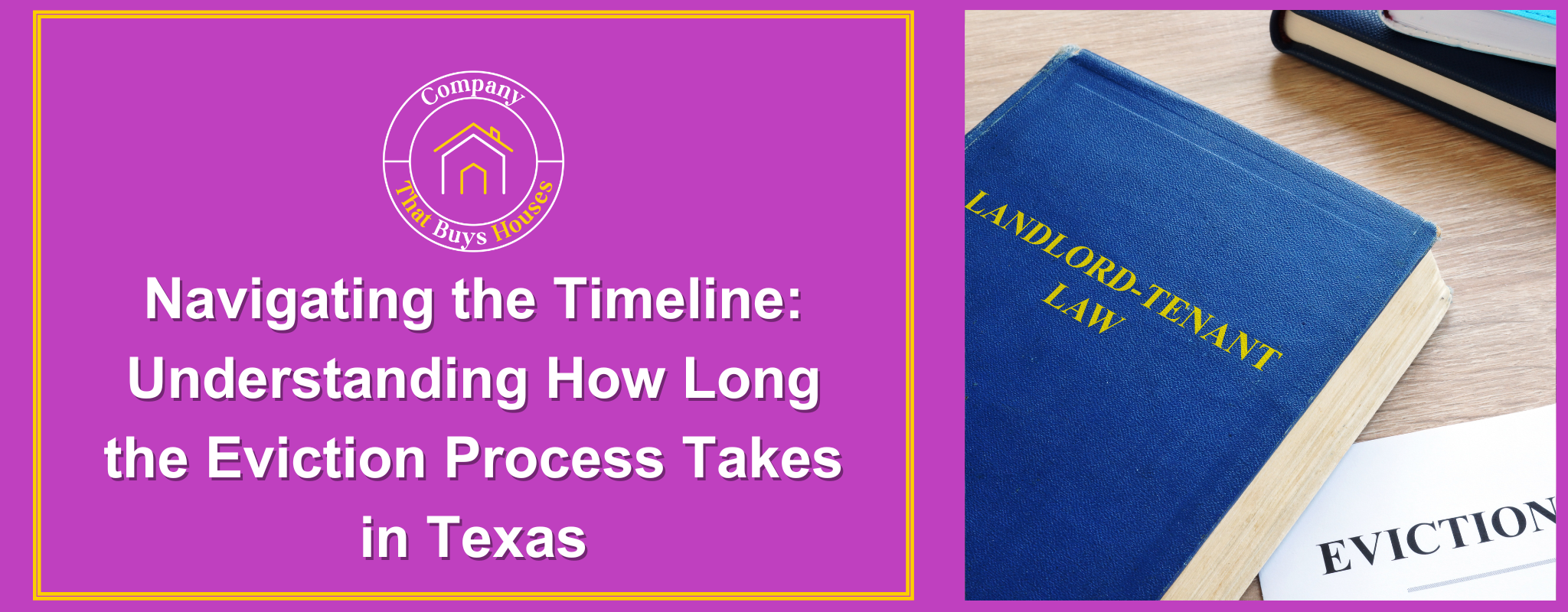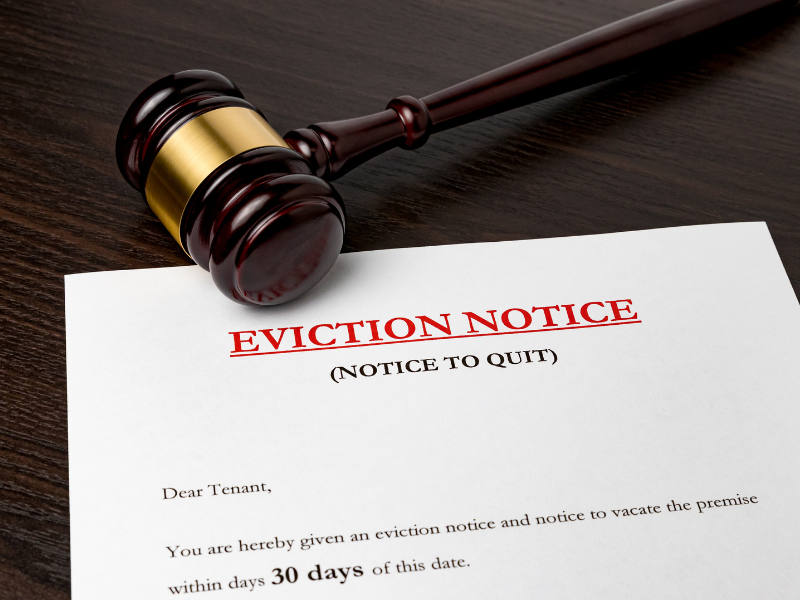
Understanding The Timeframes In The Eviction Process
For landlords and renters, the eviction process in Texas can take a long time and be hard to understand. It is important for landlords to know the different time frames that are involved in the process since they can change from case to case.
A letter to vacate usually starts the eviction process. This tells the tenant how long they have to leave the property. If the tenant doesn’t do what the notice says, the landlord can go to court to get the renter kicked out.
After that, they set up a hearing usually takes about two weeks. The owner will get a judgment of possession if they win the case. They then have to wait five days before they can evict the tenant.
Landlords must carefully follow these deadlines and ensure that all forms and paperwork are turned in on time so that the eviction process doesn’t get held up.
TABLE OF CONTENTS
- The Importance Of A Notice To Vacate In An Eviction
- Navigating The Eviction Suit: A Step-by-step Guide
- Demystifying The Writ Of Possession In An Eviction
- Free Download: Essential Documents For The Eviction Process
- Request Access: Tools And Resources For A Successful Eviction
- Common Eviction Reasons And How To Address Them
- Filing A Complaint: The First Step In An Eviction Case
- Comply Or Leave: Understanding The Notice To Comply In An Eviction
- Serving The Tenant: Proper Procedures For Delivering Notices In An Eviction
- Asking For Possession: Your Rights As A Landlord In An Eviction Case
- Getting Possession: Steps To Take When Tenants Refuse To Leave
- The Texas Eviction Timeline Demystified
- Showing Evidence: Building A Solid Case For Your Eviction Suit
- How Long Does An Eviction Process Typically Take In Texas?
- Preparing For A Smooth And Efficient Texas Eviction Process
- Costs Associated With The Texas Eviction Process
- Tips For Avoiding Delays And Pitfalls In The Texas Eviction Process
- Averting Legal Battles: Effective Communication With Tenants During An Eviction
- Know Your Rights As A Landlord: Navigating Tenant Defenses In An Eviction Case
- How Fast Can You Be Evicted In Texas?
- Do You Have 30 Days After Eviction Notice In Texas?
- How Long After Eviction Court Date Do You Have To Move In Texas?
- How Far Behind On Rent Before Eviction In Texas?
The Importance Of A Notice To Vacate In An Eviction
A Notice to Vacate is an integral part of the eviction process in Texas. The tenant has been officially told by this letter that they have broken the terms of their lease and have a certain amount of time to leave the property.
It is an essential document for landlords as it provides legal proof that the tenant was notified of their violation and given a chance to remedy it before further actions are taken. Landlords may face challenges in court without a valid Notice to Vacate if they need to pursue an eviction.
Therefore, it is vital for landlords to understand the importance of a Notice to Vacate and ensure that it is properly issued according to Texas laws and regulations.
Navigating The Eviction Suit: A Step-by-step Guide

It can be hard for landlords in Texas to figure out how to remove tenants. Knowing the steps that go into an eviction suit is important because there are tight deadlines, complicated rules, and many forms to fill out.
The first step is to give the tenant written notice to vacate. This gives them a certain amount of time to leave before formal action is taken. If the renter doesn’t follow the rules, the owner can file a petition with the court and give it to the renter.
From there, both parties will attend a hearing where evidence will be presented and a judgment will be made. If the ruling favors the landlord, they can request a writ of possession from the court to legally remove the tenant from the property.
It is crucial for landlords to follow each step carefully and accurately adhere to all laws and regulations to navigate an eviction suit in Texas successfully.
Demystifying The Writ Of Possession In An Eviction
Getting a Writ of Possession is an important part of the divorce process in Texas. This formal document lets the landlord remove the rental property from a tenant who has been kicked out.
Landlords may find getting a Writ of Possession hard and confusing, but knowing the deadlines, rules, and forms needed can help make this important step less scary. Landlords must follow certain rules and steps when they get a Writ of Possession. For example, they must give the renter the right notice and file the right paperwork with the court.
Landlords can easily go through the Writ of Possession process by learning about these requirements.
Free Download: Essential Documents For The Eviction Process

When you must evict a renter in Texas as a landlord, having all the right paperwork is very important to ensure the process goes smoothly. The Notice to Vacate, the Petition for Eviction, and the Summons are some of these important papers.
The Petition for Eviction is the official start of the legal eviction process. The Notice to Vacate is the tenant’s first warning. The Summons tells the tenant when their court case is and gives them time to reply.
You can also help your case by having a written lease deal. You can get these forms online for free. They must be carefully filled out and given according to the rules and deadlines in The Complete Guide To The Eviction Process In Texas.
Request Access: Tools And Resources For A Successful Eviction

In Texas, owners who want to evict a tenant must know how to do it and have access to the right tools and resources. Landlords can ask to use different online tools, like eviction timeline templates, legal paperwork, and step-by-step guides.
These tools can help landlords eliminate tenants without a hitch and ensure the process goes smoothly. However, some tools can help landlords understand their legal rights and duties during an eviction.
Landlords can use these tools and resources to protect their property rights and confidently move forward with removal.
Common Eviction Reasons And How To Address Them
Regarding evictions in Texas, several common reasons may lead a landlord to begin the process. These reasons include non-payment of rent, violation of lease terms, property damage, and illegal activities on the premises.
To address these issues, landlords must follow the proper legal procedures outlined by Texas laws. This includes providing written notices and allowing tenants to rectify the issue before proceeding with an eviction.
Landlords should also ensure they have all the necessary documentation and evidence to support their case in court. It is important for landlords to familiarize themselves with the specific laws and timelines for evictions in Texas to avoid any potential legal complications.
Filing A Complaint: The First Step In An Eviction Case

The first step in an eviction case is to file a complaint in Texas. In this step, the landlord publicly tells the tenant they are being kicked out and gives them written notice to leave the property.
Texas state law says that the notice must include specific information, like the reason for the eviction, when the tenant needs to move out, and any other important information. When landlords file a complaint, they should use the right forms and follow all the steps to make a good case for eviction.
Not doing so could cause delays or even get the case thrown out. Before making a complaint, landlords should carefully consider why they are evicting a tenant and ensure they have all the necessary paperwork.
Comply Or Leave: Understanding The Notice To Comply In An Eviction
In Texas, owners have to follow strict rules to eliminate a tenant. This includes giving the renter written notice to do what you want before you start the eviction process.
The notice to comply lets the renter know that they are not following the rules of their lease and gives them a chance to make things right. The notice must clearly state the specific violation and give the tenant a fair amount of time to make it valid.
When landlords send out a warning to comply, they should know their rights and duties because any mistakes or missing information could cause the eviction case to be delayed or even thrown out. Landlords need to fully understand this part of the eviction process to eliminate renters who don’t follow the rules.
Serving The Tenant: Proper Procedures For Delivering Notices In An Eviction
When evicting a tenant in Texas, serving proper notice is crucial. Landlords must follow specific procedures when delivering notices to their tenants to ensure the eviction process is legal and fair.
The first step is determining which type of notice is required based on the reason for eviction. For non-payment of rent, landlords must serve a 3-day notice, while a 10-day notice is necessary for lease violations.
It’s important to format properly and include all required information in the notice, such as the date, reason for eviction, and how much time the tenant has to rectify the issue before further action. Notices can be served in person or via certified mail with a return receipt requested.
Keeping accurate records of all notices and delivery methods is critical in case of any legal disputes during the eviction process.
Asking For Possession: Your Rights As A Landlord In An Eviction Case
If you’re a landlord in Texas, it’s important to know your rights during an eviction. One of the most important parts of evicting someone is asking to take back their goods.
Like any other landlord, you can ask your renter to leave if they break the rules of their lease or don’t pay rent. It is important to follow the steps and deadlines set by Texas law, though.
This includes warning the tenant and asking the court to hear the case. Also, tenants have rights, like the right to react to the eviction notice and tell their side of the story in court.
If a landlord knows these rights, they can handle an eviction case more easily.
Getting Possession: Steps To Take When Tenants Refuse To Leave
Texas landlords must follow certain steps when dealing with a renter who refuses to leave to regain control of their property. The first step is to give the renter a written notice to vacate. This notice should explain why they are being kicked out and give them a certain amount of time to leave.
When a tenant doesn’t follow the rules, the landlord can sue to get the renter kicked out and go to court. If the court sides with the owner, they will be given a writ of possession, which lets them physically kick the tenant out of the property.
If landlords want to get back into their properties, they must follow these steps exactly and do everything the law says.
The Texas Eviction Timeline Demystified
Landlords and renters in Texas may find the eviction process overwhelming, but it’s important to know when things need to be done. In Texas, evicting a tenant usually starts with a written notice to vacate. This gives the renter a certain amount of time to leave or face legal action.
If the tenant doesn’t do what the owner says, the landlord can file a forcible entry and detainer (FED) suit to get the tenant to leave the property. After that, a court hearing will happen between 10 and 21 days.
If the landlord wins the case, they will get a writ of possession and serve it on the renter. This will give them another 24 hours to leave the property before a police officer can take them away. It’s important to remember that deadlines can change for things like holidays and weekends.
Understanding these steps and acting quickly can help the Texas divorce process go faster.
Showing Evidence: Building A Solid Case For Your Eviction Suit
If you want to kick out a tenant in Texas, you need to have a good case. To legally kick out a tenant, landlords must prove that the reasons for the eviction are true and in line with Texas law.
Written notices, lease agreements, and other related documents or conversations between the landlord and tenant can be used as proof. It’s important for landlords to keep thorough records of all interactions with tenants and any times they break the lease.
Giving clear and concise proof will help the eviction case and ensure that everything goes smoothly and quickly.
How Long Does An Eviction Process Typically Take In Texas?
If you want to kick out a tenant in Texas, the time can vary based on several things. Evicting someone can take anywhere from three weeks to a few months.
The first thing that needs to be done is to give the renter a notice to vacate. This usually gives them three days to leave. If they don’t follow through, the owner can go to court to get them kicked out.
After that, the time frame can change based on how quickly the court handles cases and sets up meetings. But landlords should know that renters can ask for a trial by jury, which could make the process take longer.
To keep the eviction process moving quickly, renters must follow all the legal steps and provide the right paperwork.
Preparing For A Smooth And Efficient Texas Eviction Process
If you’re a landlord in Texas, you should know what to expect from the removal process so that everything goes smoothly. First, you should learn about the exact rules and deadlines for evictions in Texas.
To do this, you need to know how to serve notices to tenants properly and how long you have to give notice before you can file an eviction case. Also, renters must ensure they have all the forms they need, like the Notice to Vacate and Petition for Eviction, ready and filled out correctly.
Also, if there is a dispute over the removal, having all the proof you need of lease violations or rent not paid is important. Landlords in Texas can keep the eviction process as smooth and quick as possible by being well-informed and prepared.
Costs Associated With The Texas Eviction Process

In Texas, landlords must know the possible costs of evicting a tenant. Firstly, some fees need to be paid to start a removal case.
Depending on the county, these fees can range from $100 to $300. Also, landlords may have to pay for things like paying a process server or sending the notice of eviction through certified mail, which can add to the costs.
If the case goes to court, there may be extra fees for a lawyer and court filing fees. Before starting the eviction process, renters should carefully consider these possible costs so they don’t get caught off guard by unexpected costs.
Tips For Avoiding Delays And Pitfalls In The Texas Eviction Process
In Texas, owners must follow strict rules and laws when they want to eliminate a tenant. But there are things managers can do to speed up the eviction process and keep it from going wrong.
One important tip is ensuring all forms are correctly filled out and turned in on time. Landlords should also ensure they have provided the tenant with proper notice before beginning the eviction process.
Also, it’s important to keep careful records of all conversations with the tenant and any problems during the process. One more thing that can help landlords get through the complicated eviction process faster is getting legal advice or help from a professional removal service.
If renters follow these tips, they can keep the Texas eviction process moving quickly and without problems.
Averting Legal Battles: Effective Communication With Tenants During An Eviction
When evicting tenants in Texas, the best way to avoid legal fights is to talk to them. Landlords must ensure they follow the state’s rules and deadlines so they don’t have problems with their renters.
As part of this, tenants must be given proper notice of the eviction and a chance to fix any problems before formal action. It’s important for landlords to be clear with renters about what is expected of them and what will happen if they don’t follow through. They should also keep the lines of communication open throughout the process.
Also, ensuring you have all the forms and paperwork you need ready and organized can speed up the eviction process and avoid confusion or delays. Landlords in Texas can greatly lower their chances of having to go to court during an eviction by putting good communication first.
Know Your Rights As A Landlord: Navigating Tenant Defenses In An Eviction Case
If you are a landlord in Texas, you need to know your rights regarding tenant arguments in an eviction case. Even though evicting a tenant may seem simple, renters have legal rights that can make things more difficult.
Some tenants might say that they weren’t given enough warning of the eviction or that the landlord didn’t keep the property in good shape as required by state law. Landlords should know these possible arguments and how they can change the time frame for evicting a tenant.
If you learn about these issues and become familiar with the relevant laws and forms, you can easily handle any tenant defenses and successfully carry out an eviction in Texas.
How Fast Can You Be Evicted In Texas?

The eviction process in Texas can be hard, and landlords and renters must get it done quickly. Because state rules set tight deadlines, knowing the whole process is important to ensure the eviction goes smoothly and quickly.
In Texas, evicting someone can take three to six weeks, based on the case details. But this time frame can be cut down by a lot if the necessary forms and notes are filled out and sent in on time.
Landlords must follow all state laws and rules, such as giving renters the right amount of notice and following the right legal steps. As you read through this full guide to the eviction process in Texas, you can be sure that any eviction case will be handled quickly.
Do You Have 30 Days After Eviction Notice In Texas?
If you are a landlord in Texas, it is important to understand the eviction process and the timeframe involved. In most cases, you must wait at least 30 days before proceeding after serving an eviction notice to a tenant.
This timeframe allows the tenant to remedy the issue that led to the eviction notice or vacate the property voluntarily. However, if the tenant fails to comply within those 30 days, you can file for a court hearing and obtain a writ of possession.
It is crucial to follow all timelines and procedures outlined by Texas laws to evict a tenant successfully. This complete guide will provide all the information, forms, and resources needed for a smooth eviction process in Texas.
How Long After Eviction Court Date Do You Have To Move In Texas?

The eviction process in Texas can be a stressful and confusing experience for both landlords and tenants. One of the most common questions during this process is, “How long after the eviction court date do I have to move?” The answer to this question varies depending on several factors, such as the type of eviction being pursued and whether or not the tenant chooses to contest the case.
In most cases, once a judge issues an eviction order, the tenant will have anywhere from 5-10 days to vacate the property. However, this timeline may be extended if the tenant chooses to appeal the decision.
Landlords must familiarize themselves with their county’s laws and timelines to ensure a smooth and efficient eviction. Having all necessary forms and documentation ready can help expedite the process and minimize potential delays.
How Far Behind On Rent Before Eviction In Texas?
Tenants behind their rent payments can be kicked out of their homes in Texas. It can be hard to get rid of a tenant and take a lot of time, so it’s important for landlords to know the rules, deadlines, and forms that are needed.
But how far behind on rent does a person have to be before they can be kicked out? Texas law says the landlord can start the removal process once the rent is late by one day. Most owners will wait three to five days before acting if they don’t pay.
It’s important to remember that this grace period is not needed by law and can be different for each lease as agreed upon. Ultimately, owners should move quickly to evict tenants to protect their property and money.
Related Posts:
How To Become Administrator Of Estate In Texas
How Long Does A Foreclosure Take In Texas
Can Medical Bills Take Your House In Texas
| EVICTION NOTICES | NOTICE TO QUIT | MONTH-TO-MONTH | TENANCIES | TENANCY | SUBLETTING |
| LEASE AGREEMENT< | COURT OF JUSTICE | COURT OF LAW | LEGAL PROCEEDINGS | COUNTY SHERIFF | SHERIFF |
| DISABILITIES | DISABILITY | RENTAL AGREEMENT | REAL ESTATE | FORECLOSURE | DOOR |
| NON-COMPLIANCE | COMPLIANCE | LEGAL REMEDIES | REMEDIES | ATTORNEY | EMAILS |
| DISCRIMINATION | DISCRIMINATING | SEX | PROBABLE CAUSE | FAIR HOUSING | DRUG |
| FAIR HOUSING ACT | MONEY | LAW ENFORCEMENT | JUSTICE | ACTUAL DAMAGES | DAMAGES |
| CONSUMPTION | PROPERTY OWNER | SUBSTITUTED SERVICE | RETALIATORY EVICTION | POLICE | MORTGAGE |
| LANDLORD-TENANT LAWS | LANDLORD-TENANT ISSUES | COURT RULING | CIVIL PENALTIES | CIVIL PENALTY | CARES ACT |
| THE TENANT IS | THE TENANT IN | FOR NONPAYMENT OF | GIVE THE TENANT | NONPAYMENT OF RENT | THE LANDLORD MUST |
| RENT IN TEXAS | THE TENANT OR | ON THE PROPERTY | TO THE TENANT IN | FOR NONPAYMENT OF RENT | SERVE THE TENANT WITH |
| THE TENANT AT LEAST | TO THE TENANT OR | 3DAY NOTICE TO QUIT |
![Trustworthy Cash Home Buyer [market_city] [market_state]](https://image-cdn.carrot.com/uploads/sites/75713/2024/01/Trustworthy-Cash-Home-Buyer.png)
